ZPU
The ZPU (Russian: ЗПУ; зенитная пулемётная установка/zenitnaya pulemotnaya ustanovka, meaning "anti-aircraft machine gun mount") is a family of towed anti-aircraft gun based on the Soviet 14.5×114mm KPV heavy machine gun. It entered service with the Soviet Union in 1949 and is used by over 50 countries worldwide.
| ZPU anti-aircraft gun | |
|---|---|
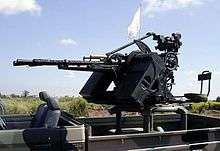 ZPU-2 | |
| Type | Anti-aircraft gun Autocannon |
| Place of origin | Soviet Union |
| Service history | |
| In service | 1949–present |
| Used by | See Operators for users |
| Wars | Korean War Vietnam War Yom Kippur War Rhodesian Bush War Western Sahara War Angolan Civil War Cambodian Civil War Lebanese Civil War Soviet–Afghan War South African Border War Somali Civil War Gulf War Georgian Civil War South Lebanon conflict (1985–2000) First Chechen War Second Congo War[1] Second Chechen War War in Afghanistan (2001–present) Iraq War 2006 Lebanon War Russo-Georgian War First Libyan Civil War Sudanese conflict in South Kordofan and Blue Nile[2] Syrian Civil War Second Libyan Civil War War in Donbass Yemeni Civil War (2015–present) Saudi Arabian-led intervention in Yemen |
| Production history | |
| Manufacturer | Zpu |
| Variants | ZPU-1, ZPU-2, ZPU-4 |
| Specifications | |
| Shell | 14.5x114 |
| Caliber | 14.5 mm |
| Barrels | 1-4 |
| Action | Gas operated |
| Effective firing range | 1.4km |
| Maximum firing range | 8km |
- For the ZPU microprocessor, see ZPU (microprocessor).
Quadruple (ZPU-4), double- (ZPU-2 and ZU-2) and single-barreled (ZPU-1) versions of the weapon exist.
Precursor
The first dedicated Soviet mount for anti-aircraft machine guns was developed around 1928 by Fedor Tokarev and was adopted for service in 1931. It was a base for mounting up to four 7.62 mm PM M1910 (Russian Maxim) guns. This was also called a ZPU, although the name М-4 was also assigned to it. It served the Soviet armed forces in all major conflicts until 1945.[3] 12.7 mm DShK 1938 was used an anti-aircraft weapon it was mounted on pintle and tripod mounts, and on a triple mount on the GAZ-AA truck. Late in the war, it was mounted on the cupolas of IS-2 tanks and ISU-152 self-propelled guns. As an infantry heavy support weapon it used a two-wheeled trolley which unfolded into a tripod for anti-aircraft use.
Description
Development of the ZPU-2 and ZPU-4 began in 1945, with development of the ZPU-1 starting in 1947. All three were accepted into service in 1949. Improved optical predicting gunsights were developed for the system in the 1950s.
All weapons in the ZPU series have air-cooled quick-change barrels and can fire a variety of ammunition including API (B32), API (BS41), API-T (BZT) and I-T (ZP) projectiles. Each barrel has a maximum rate of fire of around 600 rounds per minute, though this is practically limited to about 150 rounds per minute.
The quad-barrel ZPU-4 uses a four-wheel carriage similar to that once used by the obsolete 25 mm automatic anti-aircraft gun M1940. In firing position, the weapon is lowered onto firing jacks. It can be brought in and out of action in about 15 to 20 seconds, and can be fired with the wheels in the traveling position if needed.
The double-barrel ZPU-2 was built in two different versions; the early model has large mud guards and two wheels that are removed in the firing position, and the late model has wheels that fold and are raised from the ground in the firing position.
ZPU-2 turned out to be too heavy for the Airborne Troops, so a new UZPU-2 (later redesignated as ZU-2) was developed from ZPU-1.
The single-barrel ZPU-1 is carried on a two-wheeled carriage and can be broken down into several 80-kilogram pieces for transport over rough ground.
Versions of the weapon are built in China, North Korea and Romania.
History
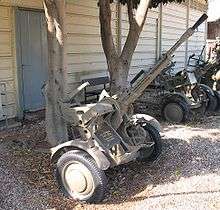
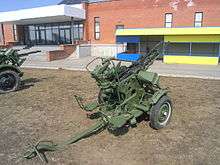
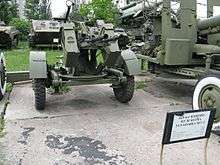
The series was used during the Korean War by Chinese and North Korean forces, and was later considered to be the most dangerous opposition to U.S. helicopters in Vietnam. Later it was used by Morocco and the Polisario Front in the Western Sahara War. It was also used by Iraqi forces during Operation Desert Storm and again in Operation Iraqi Freedom. In 1974 the Cyprus National Guard artillery batteries used their ZPU-2's against the Turkish air force. In the Russian military, it was replaced by the newer and more powerful ZU-23 23 mm twin automatic anti-aircraft gun.
During the Lebanese Civil War, the Lebanese militias mounted the ZPU-2 and ZPU-4 on various vehicles, such as M113 armored personnel carriers, to create self-propelled support vehicles.[4]
The ZPU has seen widespread use by both sides in the Libyan Civil War, Syrian Civil War, and Yemeni Civil War, being often mounted on technical pickup trucks.[5][6] The weapon has also been heavily used in thebeing installed on pickup trucks and is credited for bringing down several Syrian Air Force helicopters.[7][7]
Ammunition
- API (BS.41) – Full metal jacket bullet round with a tungsten carbide core. Projectile weight is 64.4 g (2.27 oz) and muzzle velocity is 1,000 metres per second (3,300 ft/s). Armor-penetration at 500 m (550 yd) is 32 mm (1.3 in) of RHA at 90 degrees.[8]
- API-T (BZT) – Full metal jacket round with a steel core. Projectile weight is 59.56 g (2.101 oz) and muzzle velocity is 1,005 m/s (3,297 ft/s). Tracer burns to at least 2,000 m (2,200 yd).
- I-T (ZP) – "Instantaneous Incendiary" bullet with internal fuze, incendiary in tip, tracer container in base. Projectile weight is 60.0 g (2.12 oz).
Rounds are also produced by Bulgaria, China, Egypt, Poland, and Romania.
Variants
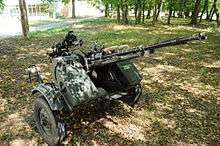
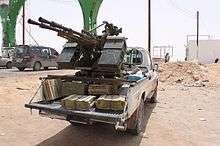
- ZPU-4
- ZPU-2
- Type 58 – Chinese-built version.[9]
- PKM-2 – Polish-built version.
- ZU-2
- ZPU-1
- Type 75 and Type 75-1 - Chinese built-versions.[9]
- BTR-40A SPAAG – A BTR-40 APC with a ZPU-2 gun mounted in the rear. Entered service in 1950.
- BTR-152A SPAAG – A BTR-152 with a ZPU-2 mounted in the rear. Entered service in 1952.
Specifications
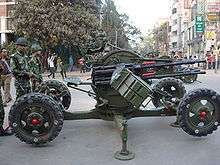
| Model | ZPU-1 | ZPU-2 | ZU-2 | ZPU-4 |
|---|---|---|---|---|
| Barrels | 1 | 2 | 2 | 4 |
| Weight (travelling) | 413 kg (910 lb) | 994 kg (2,191 lb) | 649 kg (1,430 lb) | 1,810 kg (3,990 lb) |
| Weight (firing) | 413 kg (910 lb) | 639 kg (1,408 lb) | 621 kg (1,369 lb) | 1,810 kg (3,990 lb) |
| Length (travel) | 3.44 m (11.28 ft) | 3.54 m (11.61 ft) | 3.87 m (12.69 ft) | 4.53 m (14.86 ft) |
| Width (travel) | 1.62 m (5.31 ft) | 1.92 m (6.29 ft) | 1.37 m (4.49 ft) | 1.72 m (5.64 ft) |
| Height (travel) | 1.34 m (4.39 ft) | 1.83 m (6.00 ft) | 1.1 m (3.60 ft) | 2.13 m (7 ft) |
| Elevation | +88/−8 | +90/−7 | +85/−15 | +90/−10 |
| Traverse | 360 | |||
| Maximum range | 8,000 m (8,749 yds) | |||
| Maximum altitude | 5,000 m (16,404 ft) | |||
| Effective altitude | 1,400 m (4,593 ft) | |||
| Ammunition (rounds) | 1,200 | 2,400 | 4,800 | |
| Crew | 4 | 5 | ||
Operators




























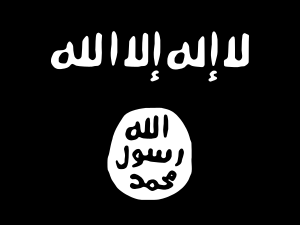






















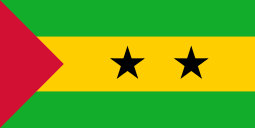







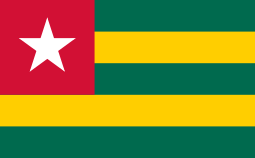


.svg.png)



See also
References
- Cooper, Tom (2013). Great Lakes Conflagration: Second Congo War, 1998 2003. UK: Helion & Company Limited. p. 39. ISBN 978-1-920143-84-8.CS1 maint: ref=harv (link)
- "SPLA-N weapons and equipment, South Kordofan, December 2012" (PDF). HSBA Arms and Ammunition Tracing Desk. Small Arms Survey: 8. February 2013. Archived (PDF) from the original on 2016-03-22. Retrieved 2019-01-02.
- Семен Федосеев (2009). Пулеметы России. Шквальный огонь. Яуза / Коллекция / ЭКСМО. pp. 377–380. ISBN 978-5-699-31622-9.
- Zaloga, Steven J. (2003). Tank battles of the Mid-East Wars (2): The wars of 1973 to the present. Hong Kong: Concord Publications. p. 7. ISBN 962-361-613-9.
- "Rebels down Libyan aircraft as world leaders discuss next move". arabianbusiness.com. Retrieved 6 May 2018.
- Neville 2018, p. 34.
- Neville, Leigh (19 Apr 2018). Technicals: Non-Standard Tactical Vehicles from the Great Toyota War to modern Special Forces. New Vanguard 257. Osprey Publishing. p. 10. ISBN 9781472822512.CS1 maint: ref=harv (link)
- "Archived copy". Archived from the original on 2011-10-12. Retrieved 2011-10-10.CS1 maint: archived copy as title (link)
- Gander, Terry J. (4 May 2001). "14.5 mm KPV heavy machine gun". Jane's Infantry Weapons 2002-2003. pp. 3732–3734.
- Bhatia, Michael Vinai; Sedra, Mark (May 2008). Small Arms Survey (ed.). Afghanistan, Arms and Conflict: Armed Groups, Disarmament and Security in a Post-War Society. Routledge. p. 66. ISBN 978-0-415-45308-0. Archived from the original on 2018-09-01. Retrieved 2018-09-01.CS1 maint: ref=harv (link)
- Military Balance 2017
- Military Balance 2017
- Cherisey, Erwan de (July 2019). "El batallón de infantería "Badenya" de Burkina Faso en Mali - Noticias Defensa En abierto". Revista Defensa (in Spanish) (495–496).
- Military Balance 2017
- Cooper 2013, p. 25.
- "Syrie: l'EI inflige un revers aux FDS dans l'est, mais reste acculé". France Soir (in French). 25 October 2018. Archived from the original on 25 October 2018. Retrieved 4 March 2019.
- Military Balance 2017
- Military Balance 2017
- Military Balance 2017
- Military Balance 2017
- Military Balance 2017
- Military Balance 2017
- Military Balance 2017
- Jones, Richard D.; Ness, Leland S., eds. (January 27, 2009). Jane's Infantry Weapons 2009/2010 (35th ed.). Coulsdon: Jane's Information Group. ISBN 978-0-7106-2869-5.
- Military Balance 2017
- Military Balance 2017
- Military Balance 2017
| Wikimedia Commons has media related to ZPU series. |
- Jane's Land Based Air Defence 2005-2006. ISBN 0-7106-2697-5
- Koll, Christian (2009). Soviet Cannon - A Comprehensive Study of Soviet Arms and Ammunition in Calibres 12.7mm to 57mm. Austria: Koll. p. 98. ISBN 978-3-200-01445-9.
External links
- ZPU-1 single barrel anti-aircraft gun data sheet
- ZPU-2 anti-aircraft 14.5 mm twin guns data sheet
- http://en.rcamuseum.com/our-collection/zpu-4-anti-aircraft-gun-14-yugo
- ZPU-4 anti-aircraft 14.5 mm quadruple guns data sheet
- Video: ZPU-1 (single-barreled 14.5) being fired in Afghanistan
- Video: ZPU-2 (14.5) being fired in Syria from a technical